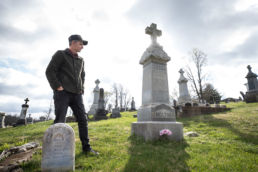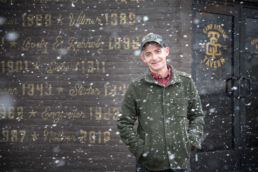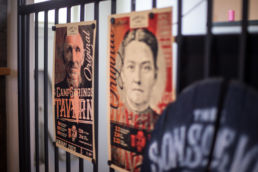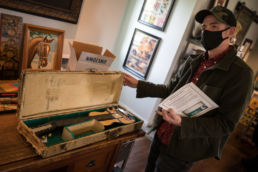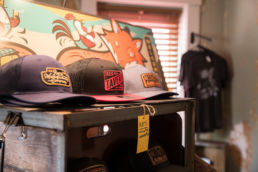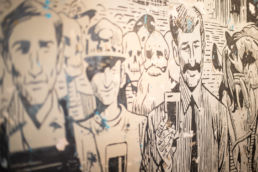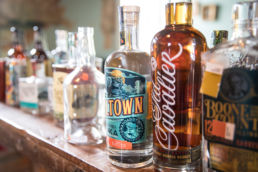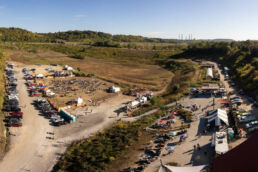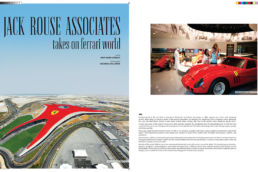words & photography | MATT STEFFEN
We are all the sum of many parts, the culmination of decisions of our own making. Introduced into the game to play the hand we’ve been dealt, often forged by the choices of our fathers and their fathers ad infinitum. Keith Neltner, son of Clarence (b. 1940), son of Lawrence (b. 1904), son of Joseph (b. 1859), son of Joseph (b. 1823). For a century and a half, all tillers of soil, builders, and self-reliant problem solvers, no strangers to labor. Settlers and landholders of Camp Springs, Kentucky, a serene and rolling pastoral tucked just out of the way, still scattered with stone homes built by German immigrants in the middle of the nineteenth century. Keith finds himself, as father and provider with an eye on the future, standing on the shoulders of generations past. He is rooted in the same plot, planted and dreamed of so long ago, a caretaker of legacy and reimaginer of place.
Keith grew up working on his family’s farm, like the five generations before him. A stretch of land purchased from in-laws in 1892, it would be the first of many plots in the region worked by Neltners. His father, a carpenter by trade, took over in the 1970s to help his aging parents. The family would fill their ’64 Impala with crates of strawberries, squash, potatoes, or whatever the season provided, and bring their wares to the church parking lots and roadside intersections in town. People would stop to buy produce from the cute kids in the back of the truck, kids that labored long hours after finishing their schoolwork, and even longer days in summer. Keith can still tell you the commute time from Camp Springs to Bellevue, Cincinnati Gardens, or Swifton Commons down to the minute, pre-AA Highway minutes, former wagon trails turned numbered rural routes, circumnavigating hills and following the curves of the river.
“I mean, we just didn’t know. In hindsight, it was just a great thing, you know, just being with my family.”
Always sketching as a kid, Keith went through a visual communications program through Gateway Community and Technical College while still in high school. It taught him that a living could be made in design and creative work. The program placed him in positions with some of Cincinnati’s biggest branding stages, where he engaged with names like P&G, Kraft, and Wrigley’s. Keith was also meeting the players in the design field, who were quickly becoming mentors, peers, and friends—folks he still collaborates with today.
Farming instills a specific work ethic. Those early years of working a field six days a week, and weekends loading the truck and riding out to market had perfectly prepared Keith for agency life. Salaried employment at a desk could even be seen as tapping the brakes. But like all restless creatives, he was always working on a side hustle. The music of the ’90s was drifting into a new world of textural and distorted energy, turning its back on the mainstream. Keith was excited by the new branding that would come to symbolize such bands as the Misfits and Nine Inch Nails, marks that could elicit emotion, instantly recognizable icons able to mentally conjure the songs of the bands they represented. He wanted to create those images for the musicians he was drawn to.
“I remember getting my first job after school, and I was like, ‘I’m only showing up five days a week?’ [In agency life] you can work long hours. It didn’t faze me; I was fine with it.”
It is rare that a person goes through life from point A to point B without a detour or two. There are a million cliches about “the journey” for a reason. The best you can do is put yourself on the path, be open when the path changes, and be prepared to recognize the opportunities that are worth jumping on. Hard work might take you nowhere if your head is always down, and chance rarely rewards the idle. One of Keith’s first encounters with chance came in 1999 when he took his family to Annie’s to see Hank Williams III perform. His brother was a fan of Hank Jr., but III came out blazing with both barrels. It was a three-hour set of trajectory-changing, jaw-dropping inspiration. “It was so amped up . . . It was like watching Nirvana do a country set.” Keith went home and consumed all things music and design.
A couple years later he would approach Hank III behind the Vogue in Indianapolis to deliver his first attempt at a gig poster, a note and contact information on the back. With an underage brother in tow, Keith was denied admission to the show, but Hank handed Keith a guitar, and in the back door they went. Two weeks later, there was a call on the landline. On the other end, Keith heard “that Southern kind of drawl, and we just kind of started working together. It was a long relationship. We did a lot of cool things together, so I’m really proud of that work.”
Working with Hank had opened a door, or the truth might be that Keith had pushed his way through one. Like one of those roads leading to Camp Springs, the path would wind and turn, intersecting occasionally with the likes of Shooter Jennings, Hellbound Glory, Legendary Shack Shakers, Scott H. Biram, and the legendary Charlie Louvin.
In 1998, a young Keith and Amy Neltner purchased the old stone home next to the family farm. Never ones to shy away from a project, they began a long and historically faithful rehab of the 1852 structure. Behind it they built a gambrel-style barn for the studio, keeping everything close to home, to the family. Keith would use the skills honed in agency life to assemble his own team, Neltner Small Batch. They would spend their time following what they loved and creating not only gig posters for local and national touring acts but also branding for musicians and organizations such as Cincinnati’s own King Records and Herzog Music. They’ve created illustrations, album covers, and packaging for the Tillers, Justin Wells, Jeremy Pinnell, and Chelsea Ford. Keith’s daughter and son pop in after school to find fellow creatives at work with different ideas and processes, learning there’s a place for such things.
Keith’s team has created an aesthetic that lends itself to music. Gritty, emotional, tangible music. No pretense or unnecessary inflation, just solid work with a hand-hewn sensibility. It speaks to his childhood and his forebearers. It is in his blood and embraces his beloved Kentucky. But before you go too far down the imagined rabbit hole of Neltner Small Batch artisans toiling at the drafting table under oil-burning lamps and dipping pens in wells of handcrafted inks, know that the workflow is quite modern while still born from tradition. Images are more likely drafted and redrafted on light-table-adhered tracing paper, scanned in and digitally redrawn, and inked and vectorized before being pushed into cotton rag paper on a press that could have been used to announce the sinking of the Titanic.
“I love to buck stereotypes. It is cool seeing the music, design, and art scenes just flourishing here. I’m so glad I hung on because there is a renaissance in communities that have been sleeping for decades, history being honored and retold.”
In the late 1990s, Greater Cincinnati was losing creatives in droves. There were well-worn trails leading off to New York, Los Angeles, Chicago, and the like. The list of artists and musicians that other city’s take credit for is distinguished. Cincinnati has always taken a swing above its weight class on the national art scene, but the last decade or so has seen it reborn. Now we’re retaining our creative class, and the businesses that come along are booming. Walking through downtown, you’ll find world-class food, beverages, and public art, often in the same block. Leaving never did appeal to Keith, “I think that enough of us stuck around and get to do our own thing.” Within these burgeoning industries, Neltner Small Batch fits well. They’ve been behind the branding experience of Braxton Brewing Company, Lucius Q, the Skeleton Root Wine Makers, Boone County Distilling Company, as well as longer-tenured venues like Arnold’s Bar and Grill.
In 2013, another turn came over the horizon, a slow burner of an opportunity. Keith was approached by Halfcut Growler Shop, an OTR venue offering a wide selection of rare and exciting regional and national beers. They were looking for help with their name, branding, and interior, including a large painted mural. Having never scaled anything up to that level, Keith took advice from an old mentor. “You got to do it, whatever it takes . . . just figure it out.” The finished Halfcut mural then caught the attention of Cincinnati mural powerhouse ArtWorks. The next year, they approached Keith to design a massive mural for the newly coined Brewery District and lead a team of youth apprentices in creating it. What culminated was a five-story love letter to Cincinnati’s brewing heritage, painted on the historic Crown Brewing Company building. “Beer is proof that the Earth rewards the industrious,” reads the mural, a never truer statement to describe the art and artist. That Halfcut mural has spawned a bevy of large-scale works created for Braxton Brewing Company’s Covington Taproom, Teri Studios, Lucius Q’s facade, the taproom of 450 North Brewing in Columbus, the lobby of the Nancy & David Wolf Holocaust & Humanity Center in Union Terminal, and a recently announced mural commemorating King Records’ legends at the freshly built PromoWest Pavilion at Ovation music venue in Newport.
Keith, with Neltner Small Batch, has spent the last twenty-plus years burning the candle at both ends, making work they can be proud of for the people and places they love. It’s an incredible journey and one that grew honestly and unencumbered. When there was a knock at the door, the door was answered, with a friend and peer brought along to lend expertise. And when the job was done, there was a new tool in the toolbox, ready for that next knock. When 2016 came along, it tried to knock that door off its hinges.
Sitting precariously close to the intersection of Four Mile and Stonehouse Roads, just across from Neltner farm, is what’s known locally as “The Corner,” an old building put together in 1865 with leftover bricks from Saint Joseph’s church, overlooking from the top of the hill. Now known as Camp Springs Tavern, it’s traded hands more than a few times over the years and has seen a few remodels and additions to accommodate its use as a post office, meeting house, general store, church when the road up the hill was not passable, and even as a morgue when the winter ground made burials difficult. Word made its way down the road to Keith and his wife that the tavern was looking for a new owner. With family support and his brother’s inherited carpentry skills, they began working on what Keith calls “one of the wildest things we’ve done.” They tore out drywall and panel board, tuck-pointing the now exposed stacked fieldstone walls, trying to restore back to original what they could. After spending his adult life building brands, learning the retail, packaging, and legal sides of the industry, and creating destinations that make people want to flock to them, it was time to use those tools for his own place.
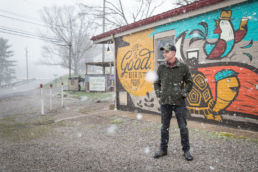
“It was like, ‘Well what if we give it a shot? So, what if we throw everything at it?’ And that’s what we’ve done.”
While doing their best to honor and restore its past, something unexpected started to breathe out of that old building. The community began stopping by to share stories and old photos. One woman brought by notes she found in courthouse archives from the original deed—a list of fifteen familiar names and the corresponding years of ownership. Someone else brought in a photo, made just before the turn of the last century, a grouping of men in two rows, weathered, stiff and upright, wearing their Sunday best with scuffed and muddy boots. In the back row stood Keith’s great-great-grandfather, hoisting a stein of dark beer. It sealed the deal. His lifelong meandering passage had brought him back home to the land his fathers worked, to stand in the same place in that photograph and to celebrate life with a stein of something malty. Owning this tavern was a way to put Neltner on that list of surnames, to make a mark and take his turn as keeper of the building, caretaker of legacy and community.
“I haven’t learned a single thing that makes them some kind of famous individual, [but] their stories are lost unless we bring them back.”
As they have for us all, things have slowed down over the last year in Camp Springs. With a pandemic shutting down the normal day to day, Camp Springs Tavern has mostly sat quiet, waiting. Keith has finally gotten the ability to catch a breath and enjoy some time with his kids. The family even added another mural to the portfolio on the south wall of the tavern, an illustration by Rob Warnick of a fox lying with chickens, encouraging us all to come together, especially in these divided times: “Life is good. Beer is proof.”
With time to reflect, it appears that all these seemingly disparate projects and people all flow back to one community. The Tavern has become a way for the Neltners to invite them in and foster that. The building has plenty of room for lounging and working. Keith has plans for taking the laptop over the hill to the Tavern and opening things up a little when regulations permit. They will brew coffee, or someone will pour you a beer, if that’s what you prefer. There is space to spread out and contain energy for fellow creatives to feed off of. The renovated boarding rooms on the second floor can hold meetings and workshops and also double handsomely as photo backdrops. Those same rooms have served as locations for limited seating farm-to-table dining experiences over the last few months. A Neltner Small Batch pop-up shop is there, too, manned by his kids, the same way he used to hawk produce from the family car.
What once was will soon be again, if you have the time and patience to wait for it to come back around. Life in a small town, events on a small scale, created in small batches.
Several lifetimes ago, Neltners came to this country to escape a turbulent life. They brought their people, their dreams and determination, and their skills. Camp Springs was a difficult land to tame, the only thing more numerous than the hills were the stones in the pastures. Nothing was given. Through hard work, grit, creativity, and pure will, they came together and got the job done. They toiled and prayed and danced together in those hills, the family names intermingling for centuries. Keith Neltner and his small family in that old stone house now take their turn to ripple through that country. Those names etched in stones perched on the hill next to St Joseph, keeping a watchful eye on the future of the valley below. May we all get to join them soon to laugh and hoist a stein or two.

